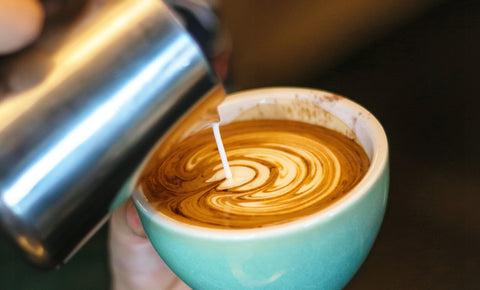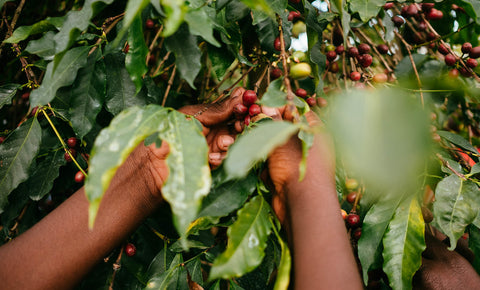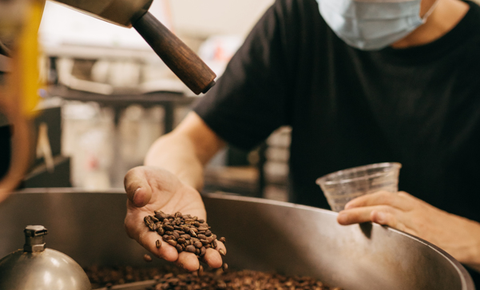Blends, they’ll never let you down.
The saying is true, you can have too much of a good thing. Too many choices don't necessarily mean easier decisions, so having a trusty go-to coffee is essential when you’re not trying to stress over yet another modern-day choice. In the category of specialty coffee, where the offerings are seasonal and fleeting, a dependable blend can be the figurative rock in a storm for your coffee needs.
There are many ways to define a blend, so let’s first clarify what our take on it is. For us, a coffee blend is any combination of two or three single origins. There are differing opinions in the industry and some may consider a mix of varieties from the same estate a ‘blend’, too. But let’s not open Pandora’s box today, and instead focus on what’s the right blend for you.
“For us, a coffee blend is any combination of two or three single origins.”
The majority of specialty coffee roasters will have their own interpretation of - what we call - flavour profiles, and no two blends with similar intentions are truly the same. A great blend can serve many purposes, but the most exciting goal is creating flavour experiences greater than the sum of their individual components.
Blends are for anyone and everyone.
No matter where you are on your coffee journey, there's no doubt that you may have run into the coffee descriptors hurdle at some point. For many, coffee tastes like, well, coffee. Hey, we understand! Reading a description of a coffee with notes of 'apricot' or 'red capsicum' or a 'syrupy' or 'juicy' mouthfeel can tend to make the selection experience a bit overwhelming.
Sometimes when we taste coffees in the roastery, we get so excited about what we’re doing that we can end up neck-deep in tasting notes, so while we’re all about sharing our enthusiasm, we still want to make the experience as approachable as possible.
Here is where the blends come in, and why we - as well as many drinkers - love them. Creating a blend allows for certain flavours to have permanent residence in our line-up.
Our Roasters take on blends.

We delve into Tam Yin Ping’s territory to learn about his perspective as our Head of Coffee and directive voice in why and how our coffees taste the way they do.
Why do blends exist? Isn’t Single Origin always better?
"There are a couple of reasons when a coffee roaster decides that the creation of a blend is an absolute necessity. Some roasters blend for financial reasons and some for flavours, with an intention to create a taste characteristic that might not inherently be present in one single-origin coffee. We all can agree that taste is subjective and may vary depending on external factors like the food and drinks we were exposed to growing up that shape our preferences. Creating blends shows our versatility to cater to different preferences."
How many coffees are too many in a blend?
"In my opinion, blends should include up to 3 coffees. In this context - less is always more, when there is too much difference made-up in a blend, there's a chance for inconsistent experiences from the intended blend profile, purely due to variety."
What are the challenges of blending coffees?
"Physically, it is extremely tiring, especially for post-blending because of the additional step of mixing it together after the coffees have been roasted. The second challenge, with respect to flavour execution, it can sometimes be pretty tricky to execute - you are forced to think about the spectrum of flavours that you want to bring out at the same time, allowing each component’s unique flavours to still shine and for the combination to complement each other. Chefs would probably be able to share the same sentiment, it’s the same concept when it comes to creating a dish; you want a harmony of ingredients."

Share an example of each component of a blend?
"CMCR Espresso can be all that you need with the incredible complexity of flavours, we taste Ripe Cherry, Stone Fruit, Milk Chocolate, and it is very versatile too, either enjoyed with Milk or on its own. For example, here’s the current breakdown of the CMCR Espresso."
Bom Jardim, Brazil - This coffee acts as the majority structure for this blend, providing base notes like Nuts & Chocolate and the general tactile experience
Risaralda, Colombia - This washed Colombia contributes to a big part of the sweetness and mid flavours to help equalise the two contrasting Single Origins
Dikitu, Ethiopia - This washed Ethiopian helps introduce high notes like citrus and berries, giving it the dimensional sensory experience and complexity
(Read: Disclaimer) Coffees are seasonal and composition changes are inevitable depending on seasonality and availability, however, it shouldn’t sway too far away from its intended profile
Inspiration behind the blends.

22 Martin is a homage to classic coffee flavours and iconic house blends that are still ubiquitous today, among the ever-evolving specialty cafe scene. Nearly all coffee roasters have something along these lines, a bold and often chocolatey and nutty option, that is perfect with milk drinks.

CMCR Espresso is our attempt at showcasing the breadth of potential in specialty coffee, from diverse fruit flavours and expressions of sweetness to chocolate and even floral tones. We wanted this to be the ‘best of specialty coffee in one place’ blend.

Lucky Basterd is inspired by combining less conventional blend components to create what is best described as a perfumey wild fruit jam, berry-infused chocolate dessert. It’s a luscious mix of rich and chocolatey flavours with fruity and floral notes.

Country Cousin is a lighter and sweeter version of CMCR Espresso that doesn’t focus on a heavy-bodied experience. We wanted this blend for those that appreciated the softer qualities of specialty coffee, especially in terms of fresh acidity and fresh fruit sugars.
How to pick a blend that you like?
- Tasting Notes
After reading this post, we hope that you are more equipped now to understand what you like and don’t like. We generally recommend starting with a flavour that you’re comfortable with and if you’re feeling adventurous, ask us for recommendations!
- Roast Dates
For Espresso, we recommend that you start using it after 7 days from the roast date, this will allow time for all the volatile compounds in the coffee to stabilize and be much more stable to extract.
- Roast Level
In a general sense, the darker the roast is, the more “brown” roast flavours you will taste. Our preferences are for a balanced taste experience with a roast level that allows all the natural characteristics from the coffee to shine.
In summary, we love a good blend.
The next time the opportunity presents itself to you, we recommend picking a different blend to try. If you’re making coffee at home, try your new coffees in all your favourite beverages because you might stumble upon a tasty combination.
We hope this written piece will be your guiding light in this adventure and that, whether you’re reading this a day or year after it’s been posted, it’s still relevant and valuable.
We should have covered enough here to set you on the path of confidence in the realm of blends. Do you have any extra questions for us? Or perhaps we missed something? Shoot us a DM on Instagram or Facebook and we’ll gladly offer any help!
Sold on this blend idea? If you’re an avid coffee drinker and want a fuss-free coffee delivery to your doorstep, check out our blend subscription program, leave all the logistics to us and you will never run out of coffee ✌️
Thank you, everyone. As usual, if you enjoy reading and want more coffee-related news, sign up for our newsletter or follow us on IG.
Written by Carmen C. & Pablo B.
From Team CMCR






